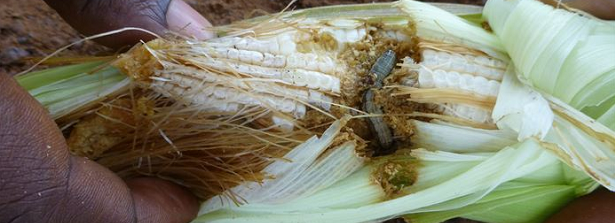A can of worms: fall armyworm invasion in Africa

The fall armyworm is still invading regions in Africa. Since 2016 this worm has been spreading across sub-Saharan Africa and has been officially identified in 11 countries. Roger Day from the Centre for Agriculture and Biosciences International (CABI) elaborates on its dangers in this blog and provides recommendations for governments and farmers.
If you were maliciously plotting how to sabotage Africa’s agriculture, introducing the fall armyworm (Spodoptera frugiperda) could well be on your shortlist of options. A denizen of the Americas, this voracious pest costs hundreds of millions of dollars a year to control in Brazil alone. The caterpillar’s favourite food is maize, the most widely grown crop in Africa and a staple for around half the continent’s people.
But forget the plotting; the fall armyworm has beaten you to it. In early 2016, the insect showed up in Africa of its own accord, although it wasn’t until some time later that the alarm bells began ringing. There are several closely related armyworms in Africa, so the first reports in Nigeria were probably thought to be the local, less harmful variety. But when specimens were properly identified, it was confirmed that the notorious fall armyworm had indeed invaded. Reports from other countries soon followed, and by mid-2017 it had already spread to many countries in East, West and Southern Africa.
How fall armyworm got to Africa is a matter of conjecture, but molecular studies suggest that there may actually have been more than one arrival. And now it’s in Africa, countries of Asia and elsewhere need to beware; fall armyworm could be coming your way next!
So how worried should Africa be?
In April 2017, using the available evidence at the time, CABI estimated the value of maize lost to the pest would be around $3bn per year, or 19% of the continent’s annual maize production. Then there’s the possible losses to other crops. It’s not yet clear how badly affected other crops might be, but part of the fall armyworm’s notoriety is due to its very wide range of host plants.
At farm level, this could be very bad news indeed. Data from the Americas show heavily infested maize can lose 60-80% of yield, which would have a serious impact on the livelihood of a smallholder farmer. Nationally or regionally, losing a fifth of maize production would have multiple consequences on maize prices, cross border trade, and food security.
What can governments do?
An international meeting in Nairobi in April 2017 developed a framework for action on fall army worms, with FAO agreed as the overall coordinator. The following are suggested as key actions, already being implemented in several countries.
Get organised. Responding to fall armyworm requires coordinated action by different stakeholders. Ghana, for example, has developed and agreed a plan and coordination mechanism for its implementation.
Give farmers good advice. Many organisations are giving advice on fall army worm control to farmers, so an important role for government is to ensure the advice is sound and consistent. This can be difficult for a new pest on which there has been no local research. Some key messages to farmers are:
- Monitor your fields for the presence and level of armyworm attack.
- Conserve and encourage fall armyworm’s natural enemies like ants, spiders and other predators that eat them and help reduce their build up.
- Use non-chemical control methods wherever possible, such as squashing the eggs and larvae by hand.
- Pesticides that kill fall armyworm can also poison people; use them only with extreme caution.
Regulate pesticides. Pesticide regulators need to be especially vigilant that unregistered and/or untested products are not being promoted and sold for controlling fall armyworm. Emergency or temporary registration can be given to products if there is supporting information from elsewhere. The International Code of Conduct for Pesticide Management provides detailed guidance. Regulators should adopt protocols and procedures that encourage the registration of lower risk pest control products.
Establish research and development. Research is needed to develop control methods and monitor their efficacy and impact; but not all research needs to be done in every country. Coordinated collaboration between national, regional and international organisations is required.
Support farmers. In the short term, smallholder farmers may need support to tackle the new pest. But giving out pesticides may be counter-productive. The damage to human health and the environment caused by pesticides is well known, so such support and/or subsidy could be used to encourage the use of lower risk products.
Déjà vu all over again
Fall armyworm is not the first new pest to invade Africa, yet each new invasion seems to catch people by surprise. Other recent unwelcome arrivals include:
- The tomato leafminer from South America (via Europe), now widespread
- A new race of Panama disease of bananas from Asia, which so far has been contained in Mozambique
- Maize lethal necrosis, first seen in Kenya in 2011, which has spread in East Africa but not to Southern or West Africa.
And fall armyworm will certainly not be the last pest to invade Africa. So while sorting out the immediate problem of fall armyworm, countries should take the opportunity to put emergency plans in place so that when the next invader arrives, the response will be much quicker, better coordinated, and more effective. CABI’s invasive species programme aims to help countries do exactly that.
Please also find more information on the costs of the Fall Armyworm pest in Africa in the CABI report “Fall Armyworm: Impacts and Implications for Africa” published in September 2017. The document quantifies the likely economic effect on agricultural sectors in affected countries and regions if left unmanaged, and draws lessons for Africa from experience controlling the pest in the Americas.





